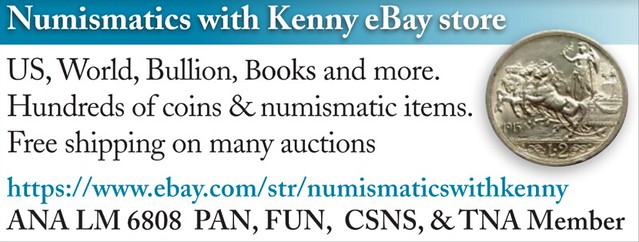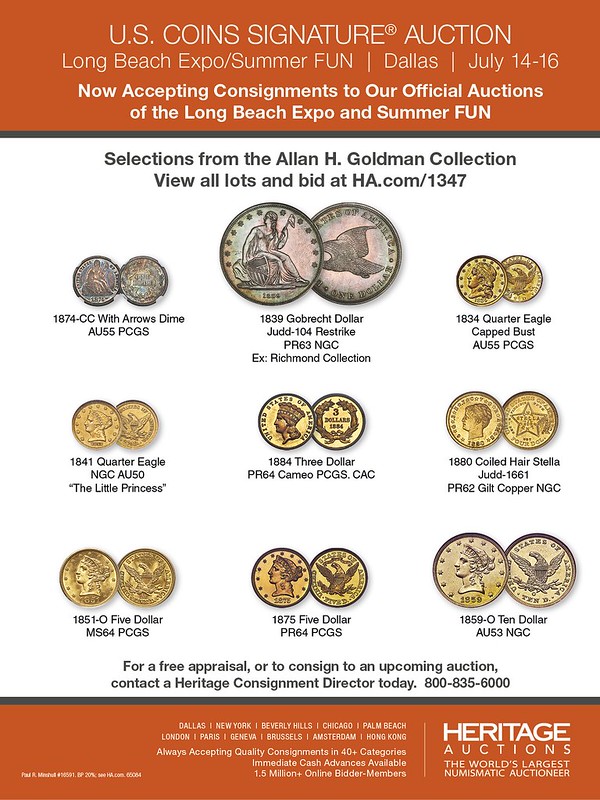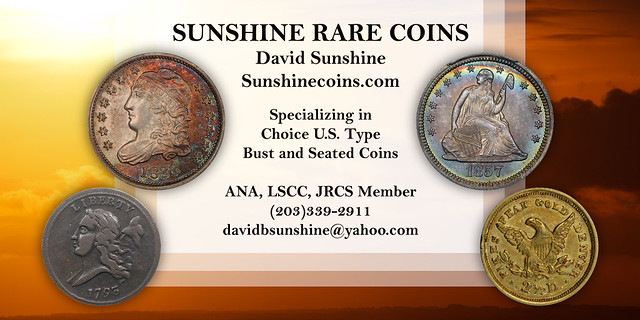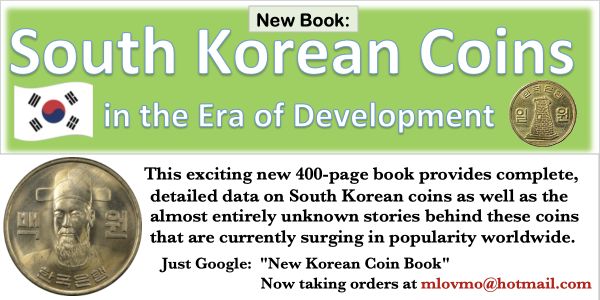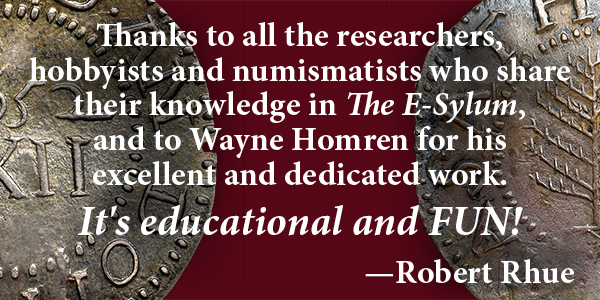
Visit our NBS Sponsors


About UsThe Numismatic Bibliomania Society is a non-profit association devoted to the study and enjoyment of numismatic literature. For more information please see our web site at coinbooks.org SubscriptionsThose wishing to become new E-Sylum subscribers (or wishing to Unsubscribe) can go to the following web page link MembershipThere is a membership application available on the web site Membership Application To join, print the application and return it with your check to the address printed on the application. Print/Digital membership is $40 to addresses in the U.S., and $60 elsewhere. A digital-only membership is available for $25. For those without web access, write to: Charles Heck, Treasurer AsylumFor Asylum mailing address changes and other membership questions, contact Chuck at this email address: treasurer@coinbooks.org SubmissionsTo submit items for publication in The E-Sylum, write to the Editor at this address: whomren@gmail.com BUY THE BOOK BEFORE THE COINSale CalendarWatch here for updates! |
- WAYNE'S WORDS: THE E-SYLUM JUNE 12, 2022
- NEW BOOK: MARY GILLICK
- NEW BOOK: COPPER COINS OF MUSCAT & OMAN
- SCRIPOPHILY APRIL 2022 ISSUE PUBLISHED
- NEWMAN PORTAL WELCOMES KELLEN HOARD
- PEALE'S 1836 REPORT ON THE NEW MINT COIN PRESS
- VIDEO: AUSTIN ANDREWS AND DR. JESSE KRAFT
- MORE ON THE MONTEFIORE MEDAL
- NOTES FROM E-SYLUM READERS: JUNE 12, 2022
- WHO WAS M.H. LINDERMAN?
- THOUGHTS ON IRIDESCENCE
- VOCABULARY TERM: JANVIER PANTOGRAPH
- AUGUSTUS SAINT-GAUDENS (1848-1907)
- HARVEY STACK'S NUMISMATIC FAMILY, PART 123
- MAKING THE REALLY BIG MONEY EXHIBIT
- THE ECONOMY MUSEUM AT THE ST. LOUIS FED
- THE MONEY MUSEUM AT THE CHICAGO FED
- ARCHIVES INTERNATIONAL AUCTION 77
- NUMISMATIC NUGGETS: JUNE 12, 2022
- WAYNE'S NUMISMATIC DIARY JUNE 12, 2022
- COINS OF JULIAN THE APOSTATE
- COINS FROM POMPEII'S RUINS
- HUNGARY FIND OF NORWAY'S KING HARALD COIN
- SAN JOSE GALLEON WRECK PHOTOGRAPHED
- THE 1817/4 HALF DOLLAR
- REDISCOVERING ELIASBERG'S 1839-C HALF EAGLE
- NOBEL PRIZE MEDAL SALE TO BENEFIT UKRAINIANS
- VATICAN MEDAL FOR UKRAINIAN WAR RELIEF
- ELIZABETH II'S IMAGE ON BANKNOTES
- MORE QUEEN ELIZABETH II BANKNOTE PORTRAITS
- AUSTRALIAN BANKNOTE FLUORESCENT INK IMAGES
- LOOSE CHANGE: JUNE 12, 2022
- FREDDIE MERCURY'S STAMP COLLECTION
Click here to read the thin version on the web
Click here to subscribe
Click here to access the complete archive
To comment or submit articles, reply to whomren@gmail.com
Content presented in The E-Sylum is not necessarily researched or independently fact-checked, and views expressed do not necessarily represent those of the Numismatic Bibliomania Society.
WAYNE'S WORDS: THE E-SYLUM JUNE 12, 2022
 New subscribers this week include:
Pedro Lousa of Portugal, courtesy Fred Liberatore;
Welcome aboard!
New subscribers this week include:
Pedro Lousa of Portugal, courtesy Fred Liberatore;
Welcome aboard!
Thank you for reading The E-Sylum. If you enjoy it, please send me the email addresses of friends you think may enjoy it as well and I'll send them a subscription. Contact me at whomren@gmail.com anytime regarding your subscription, or questions, comments or suggestions about our content.
This week we open with two new books and a new periodical issue, updates from the Newman Numismatic Portal, thoughts on iridescence, and more.
Other topics this week include Peale's 1836 report on the new mint coining press, the Montefiore medal, the Janvier pantograph, Augustus Saint-Gaudens, Federal Reserve money museums, auction previews, dug coins, sunken coins, a Nobel Peace Prize medal, Elizabeth II's image on banknotes, and the only living person other than members of the royal family to be depicted on a British stamp.
To learn more about sculptor Mary Gillick, coins of Muscat & Oman, Kellen Hoard, Austin Andrews, Jesse Kraft, Michael Powills, Officer Donald Sutherland, Liberty Dollars in coin show exhibits, Carnegie Heroes, the David Queller Family Collection, the World's Oldest Living Pioneer, and the flying pig piggy bank, read on. Have a great week, everyone!
Wayne Homren
Editor, The E-Sylum
NEW BOOK: MARY GILLICK
SPINK has published a new book on the work of sculptor Mary Gillick, known for her famous portrait of Queen Elizabeth II. -Editor
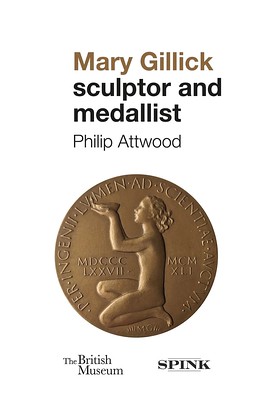 SPINK | BOOKS
SPINK | BOOKS
Mary Gillick: Sculptor and Medallist by Philip Attwood
£25.00
Mary Gillick, née Tutin (1881-1965), is probably best known for the portrait of Queen Elizabeth II that appeared on UK coins from the beginning of her reign until decimalisation in 1971. This book focuses on Gillick's career as a sculptor and medallist, which had already spanned more than fifty years when she experienced that sudden burst of fame. Her subjects range from First World War heroes to such eminent figures as the singer Kathleen Ferrier.
NEW BOOK: COPPER COINS OF MUSCAT & OMAN
Wolfgang Schuster passed along information about a new book on the copper coins of Muscat & Oman. Thanks. -Editor
 Copper Coins of Muscat and Oman dated AH 1311–1316 (1893–1899 CE)
Copper Coins of Muscat and Oman dated AH 1311–1316 (1893–1899 CE)
By Scott E. Cordry
Published by www.arabiancoins.com, New York 2021
Towards the end of the 19th century maritime trade between the major ports of the north-western Indian Ocean (Zanzibar, Aden, Muscat, Karachi and Bombay) greatly increased. Consequently, from 1893 to 1899, 1/4 Anna copper coins of Muscat and Oman were minted and circulated around the north-western Indian Ocean as regional small change. During these few years, numerous 1/4 Anna coins with a range of varieties of legends, decorative elements and die mulings as well as countermarks were struck. The book gives comprehensive information on these copper coins of Muscat and Oman bringing to light to all known varieties in a systematic presentation.
SCRIPOPHILY APRIL 2022 ISSUE PUBLISHED
Editor Max Hensley submitted this information about the latest issue of Scripophily from the International Bond & Share Society. Thanks. -Editor
The Howe Sound Co
by Max Hensley
Selling the Security – Members Contribute
by Max Hensley
Studebaker
by Bernhard Wilde
Deutsche Bank Part I: The History of Deutsche Bank AG
by Horst Klophaus
Boomtimes in the German Sugar Industry: 1850 – 1885
by Michael Fraikin
Included are reviews of two new books on stock certificates: Michigan Copper Mining Stocks and Bonds Part II by Lee Degood and Stamp Taxes in Nevada I. Silver Fever! Nevada Territory Stock Certificates, 1863-4 by Michael Mahler.
NEWMAN PORTAL WELCOMES KELLEN HOARD
The latest news from the Newman Numismatic Portal is about their new intern, Kellen Hoard. Project Coordinator Len Augsburger provided the following report. -Editor
Newman Portal Welcomes Kellen Hoard
 Newman Portal is pleased to announce that Kellen Hoard has accepted a summer internship with the Eric P. Newman Numismatic Education Society. Kellen Hoard is a recently graduated high school student from Kirkland, Washington, who has been collecting since he was 9 years old. Named Young Numismatist of the Year by the American Numismatic Association in 2021, Hoard has written widely for hobby publications, including The Numismatist, and is a board member of the Pacific Northwest Numismatic Association.
Newman Portal is pleased to announce that Kellen Hoard has accepted a summer internship with the Eric P. Newman Numismatic Education Society. Kellen Hoard is a recently graduated high school student from Kirkland, Washington, who has been collecting since he was 9 years old. Named Young Numismatist of the Year by the American Numismatic Association in 2021, Hoard has written widely for hobby publications, including The Numismatist, and is a board member of the Pacific Northwest Numismatic Association.
Hoard is politically active and has worked with the Washington State Legislature and in varying campaign roles. He served as Chair of the Legislative Youth Advisory Council, the official youth advisory body to the state legislature, where he spearheaded the writing and passage of HB 1373, which expanded mental health support access to 1.1 million Washington students. For his work in politics and advocacy, he was recognized as the Washington State Parent Teacher Association Outstanding Student Advocate of the Year, was selected as one of seven emerging national leaders by the Harvard Institute of Politics, and was chosen as a Cameron Impact Scholar, for which he received a full scholarship to any college of his choice. Hoard will be attending George Washington University in the fall.
THE BOOK BAZARRE
PEALE'S 1836 REPORT ON THE NEW MINT COIN PRESS
Locating new material for the Newman Numismatic Portal is typically a pretty methodical process, but sometimes serendipity plays a part. While searching online literature listings recently I came across a reference to an 1837 article in the British publication Mechanics Magazine titled "The New Coining-Press Of The United States Mint, Philadelphia." I passed the information on to NNP Project Coordinator Len Augsburger and he discovered that the UK article is a reprint of an article from the November 1836 Journal of the Franklin Institute. It's now been added to NNP. Here are a couple of the pages. -Editor
VIDEO: AUSTIN ANDREWS AND DR. JESSE KRAFT
These are selections from the David Lisot Video Library that feature news and personalities from the world of coin collecting. David has been attending coin conventions since 1972 and began videotaping in 1985. The Newman Numismatic Portal now lists all David's videos on their website at:
https://nnp.wustl.edu/library/multimediadetail/522852
Here's one with interviews of ANS staffers Austin Andrews and Jesse Kraft. -Editor
MORE ON THE MONTEFIORE MEDAL
Ira Rezak writes:
"You asked for a clearer picture of the Wiener medal of Montefiore. See attached."
NOTES FROM E-SYLUM READERS: JUNE 12, 2022
Book Review: Robert Scot
Bill Eckberg writes:
 "It was nice to see a new printing of Nyberg's book on Robert Scot is in print. The book contains a wealth of information about the man who was the first Chief Engraver of the US Mint, responsible for the Capped Bust coppers, all the Draped Busts (copper, silver and gold), and most likely later designs until his death in 1823.
"It was nice to see a new printing of Nyberg's book on Robert Scot is in print. The book contains a wealth of information about the man who was the first Chief Engraver of the US Mint, responsible for the Capped Bust coppers, all the Draped Busts (copper, silver and gold), and most likely later designs until his death in 1823.
"Reading the review was an interesting experience. I, of course, approach Scot as a numismatist. The review approached him as a native Scot. The reviewer seems to have found Scot's coinage work confusing, and was heavy on the Scottish Enlightenment. For most of us at The E-Sylum, I'm sure the opposite would be true."
To read the earlier E-Sylum article, see:
NEW PRINTING: ROBERT SCOT: ENGRAVING LIBERTY
(https://www.coinbooks.org/v25/esylum_v25n23a03.html)
Other topics this week include the other Lady Gregory Medal, a PCGS prototype slab with a handwritten label, Liberty dollars, and Carnegie Heroes. -Editor
WHO WAS M.H. LINDERMAN?
A letter found in the American Numismatic Society archives from an M.H. Linderman
prompted speculation that the writer might have been related to former U.S. Mint Director H.R. Linderman. Julia Casey did some sleuthing on this and provided these notes. Thank you!
-Editor
Regarding the identity of M.H. Linderman
– I believe I found a likely candidate in Minert H. Linderman (Lindeman) of Brooklyn, NY. After digging around a little, I reached out to Pete Smith, who reached out to Len Augsburger, and I was able to see a scan of the entire 1908 letter to the mint. The return address for M.H. Linderman was P.O. Box 244, Brooklyn, N.Y.
During my research I had determined this same address to be linked to Minert H. Lindeman.
I have not been able to establish any family relationship between Minert H. Lindeman and the mint director H.R. Linderman. Consequently, while I thoroughly enjoyed this research, the letter itself is probably not significant to the study of Henry R. Linderman and his actions as Director of the Mint. The death certificate of Minert H. Lindeman (1860-1927) indicates that he was the son of Martin Lindeman (b. Germany) and Ann Forbes (b. Scotland). At his death Minert was listed as an accountant,
but my research uncovered that he wore several hats during his lifetime.
THOUGHTS ON IRIDESCENCE
Daryl Haynor submitted these thoughts and definitions about the term iridescence in numismatics. Thanks! -Editor
Mr. Webster defines iridescence as a lustrous rainbowlike play of color caused by
differential refraction of light waves that tends to change as the angle of view
changes.
In the coin realm, the words iridescence
and iridescent
used to
describe a coin's appearance are almost always accompanied by the words
toning
, colors
, hues, rainbow
, multicolored
, blues
, greens
,
purples
, splashes of golden apricot pumpkin orange tangerine
, {pick a
color}
.
VOCABULARY TERM: JANVIER PANTOGRAPH
Here's another entry from Dick Johnson's Encyclopedia of Coin and Medal Terminology. -Editor
Janvier Pantograph. A die-cutting machine, one of the most exacting and precise for reducing three-dimensional bas-relief designs while simultaneously cutting a die. The mechanical engraver is named after its developer, Victor Janvier (1852-1911), who did much to improve existing die-engraving machines, most notably the Contamin. He operated two separate businesses. One, Duval & Janvier, with sculptor Paul Marie Duval, did custom reductions, die-cutting and medal making (Janvier was an accomplished medalist himself since 1892). The other was Ateliers Victor Janvier, which constructed and sold reducing machines. After his death in 1911, the later firm became Janvier, Berchot & Cie.
AUGUSTUS SAINT-GAUDENS (1848-1907)
American Numismatic Biographies author Pete Smith submitted this article on Augustus Saint-Gaudens. Thanks! -Editor
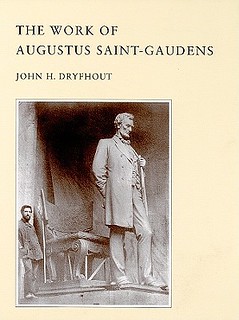 It should surprise no one that I collect numismatic literature. I also have about four feet of shelf
space devoted to art books. One cross-over item is The Work of Augustus Saint-Gaudens by John
H. Dryhout. My research will start there.
It should surprise no one that I collect numismatic literature. I also have about four feet of shelf
space devoted to art books. One cross-over item is The Work of Augustus Saint-Gaudens by John
H. Dryhout. My research will start there.
Augustus Saint-Gaudens was born on March 1, 1848, in Dublin, Ireland. His father was Bernard Paul Ernest Saint-Gaudens who was a French shoemaker. His mother was Mary McGuiness, an Irish co-worker in the shoe factory. Their last name comes from the town of Saint-Gaudens in southern France (next to Aspet) and the town was named for a Christian martyr.
The family came to Boston and settled in New York City when Augustus was six months old. In 1861 he was apprenticed to a cameo cutter. He left his apprenticeship in 1864 and began work with cameo cutter Jules Le Brethon. While working there he took drawing classes at Cooper Union and evening classes at the National Academy of Design.
HARVEY STACK'S NUMISMATIC FAMILY, PART 123
Stack's Bowers has a backlog of the late Harvey Stack's numismatic memoir articles and will continue publishing them. In this one Harvey discusses a late 1990s transitional point in numismatics, when grading services became mainstream and collectors adapted (or didn't) to the new world of slabs, all while old-time collections were coming to market. -Editor
While Harvey Stack passed away in January of this year, we are pleased to continue to offer readers the articles he had already written, so that they can be read and enjoyed as he would have wished.?
MAKING THE REALLY BIG MONEY EXHIBIT
Jennifer Gloede and Laura McClure of the National Numismatic Collection published a blog article about the Smithsonian's new exhibition "Really BIG Money". Here's an excerpt. Check out the time-lapse video! -Editor
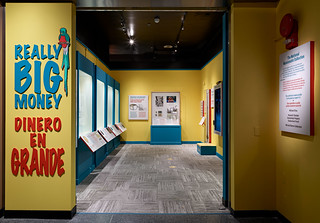 While installing a new exhibition called Really BIG Money, we—collections manager Jennifer and mount maker Laura—faced a number of challenges, mainly mounting really big objects. One of the trickiest tasks we faced was mounting 165 coins together to form a gigantic Roman coin, complete with the head of a Roman emperor.
While installing a new exhibition called Really BIG Money, we—collections manager Jennifer and mount maker Laura—faced a number of challenges, mainly mounting really big objects. One of the trickiest tasks we faced was mounting 165 coins together to form a gigantic Roman coin, complete with the head of a Roman emperor.
Before we dive into that challenge, here's the context: Really BIG Money is a new exhibition featuring monetary objects from the National Numismatic Collection that was written and designed with elementary-aged visitors in mind. Collections managers and mount makers are a key part of bringing exhibitions like this one to life. Collections managers care for the objects in a variety of ways, including cataloging and safely handling them. Mount makers create the structures that safely hold objects while they are on display. Creating a giant coin out of coins requires both of these skill sets—and a lot of patience.
THE ECONOMY MUSEUM AT THE ST. LOUIS FED
The St. Louis Post-Dispatch published a nice article about the reopening of the museum at the St. Louis Federal Reserve. -Editor
Most St. Louis attractions — especially the free ones — give visitors lots of bang for their buck. The latest free museum to reopen, the Economy Museum at the St. Louis Fed downtown, gives visitors bang and actual bucks.
Well, sort of.
THE MONEY MUSEUM AT THE CHICAGO FED
Not to be outdone, the Chicago Fed has a museum as well. Unfortunately, their website says it's temporarily closed. -Editor
The Money Museum at the Federal Reserve Bank of Chicago is a great way to spend a morning or an afternoon for a no-cost learning adventure. It's located inside the Chicago Federal Reserve Bank which is one of a dozen federal reserve banks serving our nation.
ARCHIVES INTERNATIONAL AUCTION 77
Here is the announcement for the June 15, 2022 sale by Archives International Auctions. -Editor
ARCHIVES INTERNATIONAL AUCTIONS OFFERS HISTORIC U.S., CHINESE & WORLD BANKNOTES, COINS & SCRIPOPHILY COLLECTION ON JUNE 15, 2022
The auction will be held by Archives International Auctions at their offices in River Edge, N.J.
NUMISMATIC NUGGETS: JUNE 12, 2022
Here's a selection of interesting or unusual items I came across in the marketplace this week. Tell us what you think of some of these. -Editor
Clemente X 1670-1676
Piastra del Giubileo, 1675, Roma, AG 31.62 g.
Ref : MIR 1943/1 (R)
TB-TTB. Rare
From the June Editions Gadoury sale of Papal coins. Worn, but still an impressive piece. -Editor
To read the complete lot description, see:
Online Auction 36
Lot 315
(https://www.biddr.com/auctions/gadoury/browse?a=2574&l=2879000)
Other topics this week include a Charlotte Coronation Medal, a Beijing Banknote Printing Plant Medal, and a flying pig piggy bank. -Editor
WAYNE'S NUMISMATIC DIARY JUNE 12, 2022
Chopmarked Twenty
COINS OF JULIAN THE APOSTATE
In his CoinWeek Ancient Coin Series, Mike Markowitz recently discussed the coinage of Julian the Apostate. Here's an excerpt - see the complete article online for much more. -Editor
 REMEMBERED AS THE
REMEMBERED AS THE Apostate
by his enemies, and the Philosopher
by his friends, Flavius Claudius Julianus–or Julian–ruled as Roman emperor from November 3, 361 CE until his death on June 26, 363. On the list of emperors, he is numbered as Julian II
, because a short-lived usurper, Julian of Pannonia, who briefly held power on the Danube frontier (c. 283-286), counts as Julian I
.
In the massacre of Constantine the Great's relatives that followed his death in 337, Julian's father and many of his kin were slain. Julian and his half-brother Gallus were spared only because of their young ages: Julian was five years old; Gallus was about 10. Our future emperor spent much of his youth under a kind of house arrest at a remote estate in Cappadocia in Anatolia (modern Turkey), closely monitored by agents of his cousin, the paranoid emperor Constantius II. Brought up by his tutors as an orthodox Christian, Julian received an excellent classical education.
COINS FROM POMPEII'S RUINS
An article in the journal Nature discusses the financial implications of coins found in the ruins of Pompeii. -Editor
HUNGARY FIND OF NORWAY'S KING HARALD COIN
A metal detectorist in Hungary unearthed a tiny medieval silver coin. -Editor
A metal detectorist has discovered a small silver coin marked with the name of a famous Viking king. However, it was unearthed not in Scandinavia, but in southern Hungary, where it was lost almost 1,000 years ago.
The find has baffled archaeologists, who have struggled to explain how the coin might have ended up there — it's even possible that it arrived with the traveling court of a medieval Hungarian king.
SAN JOSE GALLEON WRECK PHOTOGRAPHED
Ray Williams forwarded this article with new images of the wreck of the Spanish galleon San Jose, discovered off Columbia in 2015. -Editor
 Colombia's army has shared unprecedented images of the legendary San Jose galleon shipwreck, hidden underwater for three centuries and believed to have been carrying riches worth billions of dollars in today's money.
Colombia's army has shared unprecedented images of the legendary San Jose galleon shipwreck, hidden underwater for three centuries and believed to have been carrying riches worth billions of dollars in today's money.
Four observation missions using a remotely operated vehicle were sent to the wreck at a depth of almost 950 meters (3,100 feet) off Colombia's Caribbean coast, the army said in a statement late Monday.
THE 1817/4 HALF DOLLAR
A Stack's Bowers blog article by Dave Bowers discusses the famous 1817/4 Half Dollar. -Editor
Classic rarities among American silver coins have commanded attention for a long time. The 1804 silver dollar, 1802 half dime (see No. 12), 1894-S dime, 1827 quarter, and others are highlights of any collection or auction in which they appear.
REDISCOVERING ELIASBERG'S 1839-C HALF EAGLE
Ron Guth posted another Eliasberg Project progress report, this time on the 1839-C Half Eagle. Nice research. -Editor
It's always a great day when an Eliasberg coin is rediscovered. In this case, his 1839-C Half Eagle showed up in a random review of the Numismatic Detective Agency's (NDA) Condition Census for that date and mintmark. The coin itself has long been known as one of the finest examples, but the provenance was broken years ago and the Eliasberg connection was forgotten.
NOBEL PRIZE MEDAL SALE TO BENEFIT UKRAINIANS
In the June 7, 2022 issue of their Coin News newsletter, Heritage announced their upcoming sale of a Nobel Peace Prize Medal. -Editor
Dmitry Muratov, editor-in-chief of the influential Russian news outlet Novaya Gazeta, will auction his 2021 Nobel Peace Prize medal on June 20 through Heritage Auctions to benefit children and their families forced to flee Ukraine and those internally displaced since the start of the war in February. All proceeds will support UNICEF's humanitarian response for children in Ukraine and neighboring countries.
THE BOOK BAZARRE
VATICAN MEDAL FOR UKRAINIAN WAR RELIEF
A World Mint News Blog article by Michael Alexander describes the new Vatican City medal for Ukraine. -Editor
The Vatican City State Mint has released an official medal on the theme of peace in Ukraine, and as a way to join calls for a return to dialogue. On the 24th February 2022, Russian armed forces began the war against Ukraine by crossing over internationally recognised borders and occupying Ukrainian territory.
ELIZABETH II'S IMAGE ON BANKNOTES
This Bank of England Museum blog article explores Elizabeth II's image on banknotes throughout her reign. -Editor
On 6 February 2022, Queen Elizabeth II became the first British monarch to celebrate a Platinum Jubilee, marking 70 years on the throne. This June marks the 70th anniversary of her coronation, and we join the rest of the country and world celebrating her remarkable achievements as Queen.
You might be used to seeing the Queen's portraits on banknotes, but did you know the Queen is the only British sovereign to have appeared on banknotes issued by the Bank of England?
MORE QUEEN ELIZABETH II BANKNOTE PORTRAITS
The Sydney Morning Herald had another nice article about Queen Elizabeth II's banknote portraits. -Editor
Her face first appeared on banknotes in Canada in 1935 when she was just eight years old. Since then Queen Elizabeth II has featured on the currencies of at least 33 countries, with portraits depicting her up to the age of 90.
Now at 96, the Queen is celebrating her Platinum Jubilee - or 70 years on the British throne. Here's a look at her life through the notes of Commonwealth countries and former British colonies.
AUSTRALIAN BANKNOTE FLUORESCENT INK IMAGES
Australian social media users went into a spin after someone discovered that every Aussie banknote features a hidden image. -Editor
Reddit users went into a spin on Monday after a sleuth discovered that shining a UV light on Aussie banknotes revealed hidden images of birds.
Reddit user C_Horse21 made the discovery with a $100 note and shared it online, quickly racking up over 2400 upvotes
and setting off a frenzy in the comments.
LOOSE CHANGE: JUNE 12, 2022
Here are some additional items in the media this week that may be of interest. -Editor
We're discussed the physical cryptonotes offered by Noteworthy, a startup company that hired an all-star cast of professionals to design their product. This article says the notes were to be unveiled at a conference this past week. -Editor
Noteworthy, the premier architect of physical cryptonotes is excited to announce the next phase of its project with the official reveal of its 1 bitcoin cryptonote. Created by cryptocurrency pioneer Peter Vessenes and former Director of the Bureau of Engraving and Printing within the U.S. Treasury Larry Felix, alongside the foremost designers and innovators in central banking and currency printing, the notes are available for reservation and will be ready for purchase later this year.
Noteworthy Founder Peter Vessenes and MyEtherWallet Co-founder Kevin Monahan will be presenting the cryptonotes during a fireside chat on Thursday, June 9 at 5:30 p.m. Peter will be available for comment or interview on-site from June 9 - June 11.
Noteworthy notes are intricately designed and counterfeit-resistant without compromising quality. The front of the cryptonote will notate the type of the cryptocurrency, while the back is adorned with abstract concepts that represent the contemporary vision of the project. Swiss franc designer Manuela Pfrunder created each cryptonote with intentionality of design - seeking to combine color schemes and graphics that effectively represented the essence of blockchain technology. Each 1 bitcoin cryptonote contains a secure cryptographic microcontroller and offers a comprehensive suite of the banknote industry's most advanced security features.
But as of this writing I haven't seen any post-event publicity with more information or an image of the notes. Anyone? -Editor
To read the complete article, see:
Noteworthy to Unveil its Groundbreaking Physical Cryptonote at CoinDesk's Consensus Conference
(https://www.yahoo.com/now/noteworthy-unveil-groundbreaking-physical-cryptonote-155900102.html)
To read the earlier E-Sylum articles, see:
BITCOIN BANKNOTES
(https://www.coinbooks.org/v24/esylum_v24n11a32.html)
DESIGNING A BITCOIN BANKNOTE
(https://www.coinbooks.org/v24/esylum_v24n28a34.html)
Other topics this week include a controversial Maryland State Police challenge coin, and buying coins on eBay. -Editor
FREDDIE MERCURY'S STAMP COLLECTION
We've often discussed celebrity coin collectors, and once before we also mentioned this celebrity philatelist whose collection is being highlighted by Britain's Postal Museum. -Editor
 All Queen fans know how much Freddie Mercury liked to ride his bicycle but fewer are aware of the flamboyant frontman's other great childhood hobby: collecting stamps.
All Queen fans know how much Freddie Mercury liked to ride his bicycle but fewer are aware of the flamboyant frontman's other great childhood hobby: collecting stamps.
Now, for the first time, the Postal Museum is to put one of Mercury's priceless
collector's albums on show – its value enhanced by the fact that it is one of the late rock star's rare personal possessions in museum ownership.






